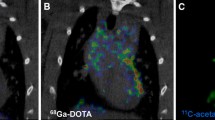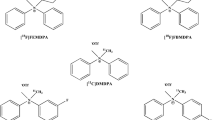Abstract
Purpose
The lipophilic cationic compound, (4-[18F]fluorophenyl)triphenylphosphonium ion (18F-FTPP) was synthesized and evaluated as a potential positron emission tomography (PET) myocardial perfusion agent.
Procedure
18F-FTPP was prepared from (4-nitrophenyl)triphenylphosphonium nitrate and ammonium [18F]fluoride by nucleophilic aromatic substitution and was purified by high performance liquid chromatography before use. Biodistribution studies were performed in rats at 5, 30, 60 min (five rats per time point). Three rats were evaluated by microPET imaging after injection of 18F-FTPP. In addition, microPET imaging in rabbits (three) was performed before and after occlusion of the left anterior descending (LAD) artery with 13NH3 (111 MBq) and 18F-FTPP (74 MBq).
Results
Biodistribution data in rats showed rapid blood clearance and high levels of accumulation in the heart; 75:1 heart-to-blood ratio at 30 min. Uptake of radioactivity in the heart was 1.64% ID/G, 1.51% ID/g, and 1.57% ID/g at 5, 30, and 60 min. At 5, 30, and 60 min, lung activity was 0.69% ID/g, 0.03% ID/g, and 0.38% ID/g, and liver uptake was 0.34% ID/g, 0.18% ID/g, and 0.17% ID/g. Heart-to-lung ratios at 5, 30, and 60 min were 2, 5, and 4. Bone accumulation was minimal. MicroPET imaging in both rats and rabbits after injection of 18F-FTPP demonstrated an initial spike of activity in the myocardium corresponding to blood flow followed by a plateau after 1 min. Region of interest analysis of microPET images of normal and LAD-occluded rabbits with 13NH3 and 18F-FTPP indicated similar distributions of the two tracers in both normal and altered blood flow regions.
Conclusion
The excellent heart-to-blood ratio of 18F-FTPP and its correlation with 13NH3 distribution in normal and LAD-occluded rabbits suggest that this radiopharmaceutical may have potential as a PET agent for characterizing mitochondrial damage and/or myocardial blood flow.






Similar content being viewed by others
References
Jadvar H, Strauss HW, Segall GM (1999) SPECT and PET in the evaluation of coronary artery disease. Radiographics 19:915–926
Gibbons RJ (2000) Imaging techniques: myocardial perfusion imaging. Heart 83:355–360
Beller GA, Zaret BL (2000) Contributions of nuclear cardiology to diagnosis and prognosis of patients with coronary artery disease. Circulation 101:1465–1478
Sabharwal NK, Lahiri A (2003) Role of myocardial perfusion imaging for risk stratification in suspected or known coronary artery disease. Heart 89:1291–1297
Keng FYJ (2004) Clinical applications of positron emission tomography in cardiology: a review. Ann Acad Med Singapore 33:175–182
Shoup TM, Elmaleh DR, Hanson RN, Fischman AJ (2004) Fluorine-18 and iodine-125 labeled tetraphenylphosphonium ions as potential PET and SPECT imaging agents for tumors [abstract]. J Nucl Med 45:447
Chen LB (1988) Mitochondrial membrane potential in living cells. Annu Rev Cell Biol 4:155–181
Wallace DC (1999) Mitochondrial diseases in man and mouse. Science 283:1482–1488
Modica-Napolitano JS, Aprille JR (2001) Delocalized lipophilic cations selectively target the mitochondria of carcinoma cells. Adv Drug Deliv Rev 49:63–70
Rieke RD, White CK, Milliren CM (1976) Electrochemical and electron paramagnetic resonance studies of a series of ammonium and phosphonium compounds. J Am Chem Soc 98:6872–6877
Summerhayes IC, Lampidis TJ, Bernal SD et al (1982) Unusual retention of rhodamine 123 by mitochondria in muscle and carcinoma cells. Proc Natl Acad Sci USA 79:5292–5296
Kamo N, Muratsugu M, Hongoh R, Kobatake Y (1979) Membrane potential of mitochondria measured with an electrode sensitive to tetraphenyl phosphonium and relationship between proton electrochemical potential and phosphorylation potential in steady state. J Membr Biol 49:105–121
LaNoue KF, Strzelecki T, Strzelecka D, Koch C (1986) Regulation of the uncoupling protein in brown adipose tissue. J Biol Chem 261:298–305
Smith JC (1990) Potential-sensitive molecular probes in membranes of bioenergetic relevance. Biochim Biophys Acta 1016:1–28, SPECT imaging agents for tumors [abstract]. J Nucl Med. 2004;45:447
Wan B, Doumen C, Duszynski J, Salama G, LaNoue KF (1993) A method of determining electrical potential gradient across mitochondrial membrane in perfused rat hearts. Am J Physiol Heart Circ Physiol 265:H445–H452
Labajova A, Vojtiskova A, Krivakova P, Kofranek J, Drahota Z, Houstek J (2006) Evaluation of mitochondrial membrane potential using a computerized device with a tetraphenylphosphonium-selective electrode. Anal Biochem 353:37–42
Berkich DA, Salama G, LaNoue KF (2003) Mitochondrial membrane potentials in ischemic hearts. Arch Biochem Biophys 420:279–286
Costa ADT, Garlid KD, West IC et al (2005) Protein kinase G transmits the cardioprotective signal from cytosol to mitochondria. Circ Res 97:329–336
Oliveira PJ, Rolo AP, Sardao VA et al (2004) Advantages in the use of carvedilol versus propranolol for the protection of cardiac mitochondrial function. J Portuguese Soc Cardiol 23:1291–1298
Monteíro P, Duarte AI, Gonçalves LM, Providência LA (2005) Valsartan improves mitochondrial function in hearts submitted to acute ischemia. Eur J Pharmacol 518:158–164
Ravert HT, Madar I, Dannals RF (2004) Radiosynthesis of 3-[18F]fluoropropyl and 4-[18F]fluorobenzyl triarylphosphonium ions. J Labelled Comp Radiopharm 47:469–476
Marshall RC, Powers-Risius P, Reutter BW et al (2004) Kinetic analysis of 18F-fluorodihydrorotenone as a deposited myocardial flow tracer: comparison to 201Tl. J Nucl Med 45:1950–1959
Marshall RC, Powers-Risius P, Reutter BW et al (2001) Kinetic analysis of 125I-iodorotenone as a deposited myocardial flow tracer: comparison with 99mTc-sestamibi. J Nucl Med 42:272–281
Huisman MC, Higuchi T, Reder S, Nekolla SG, Poethko T, Wester HJ, Ziegler SI, Casebier DS, Robinson SP, Schwaiger M (2008) Initial characterization of an 18F-Labeled Myocardial Perfusion Tracer. J Nucl Med 49(4):630–636
Yalamanchili P, Wexler E, Hayes M, Yu M, Bozek J, Kagan M, Radeke HS, Azure M, Purohit A, Casebier DS et al (2007) Mechanism of uptake and retention of F-18 BMS-747158-02 in cardiomyocytes: a novel PET myocardial imaging agent. J Nucl Cardiol 14(6):782–788
Yu M, Guaraldi MT, Bozek J, Kagan M, Azure M, Radeke H, Cdebaca M, Robinson SP (2009) Effects of food intake and anesthetic on cardiac imaging and uptake of BMS747158–02 in comparison with FDG. J Nucl Cardiol 16(5):689–690
Financial support
None
Conflict of interest statement
Dr. Shoup has no conflict of interest. He is listed on the patent as an inventor and does not own any shares or options in FluoroPharma. Dr. Fischman has no conflict of interest. He is listed on the patent as an inventor and does not own any shares or options in FluoroPharma. Dr. Elmaleh has conflict of interest. He is the scientific founder of FluoroPharma and he is listed on the patent as an inventor and owns shares and options in FluoroPharma. Dr. Brownell has no conflict of interest. Dr. Zhu has no conflict of interest. Mr. Guerrero has no conflict of interest.
Author information
Authors and Affiliations
Corresponding author
Rights and permissions
About this article
Cite this article
Shoup, T.M., Elmaleh, D.R., Brownell, AL. et al. Evaluation of (4-[18F]Fluorophenyl)triphenylphosphonium Ion. A Potential Myocardial Blood Flow Agent for PET. Mol Imaging Biol 13, 511–517 (2011). https://doi.org/10.1007/s11307-010-0349-2
Published:
Issue Date:
DOI: https://doi.org/10.1007/s11307-010-0349-2




